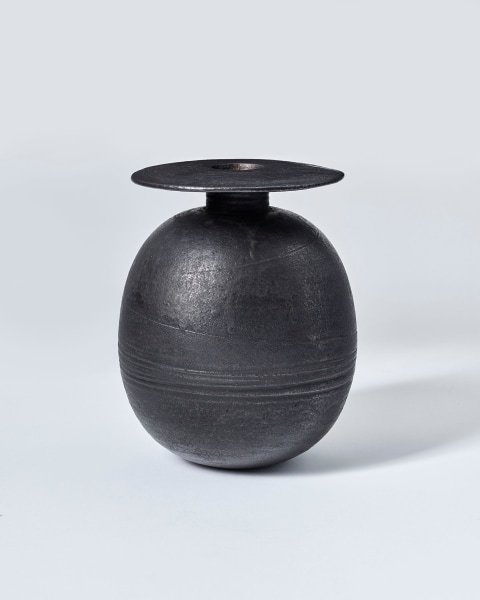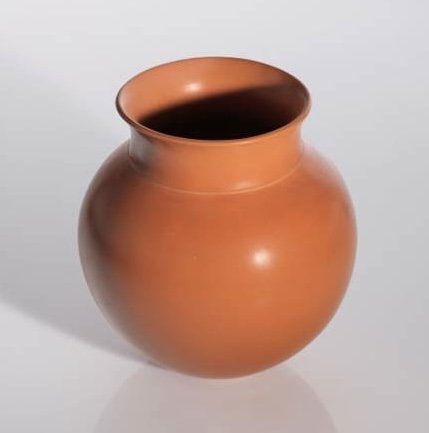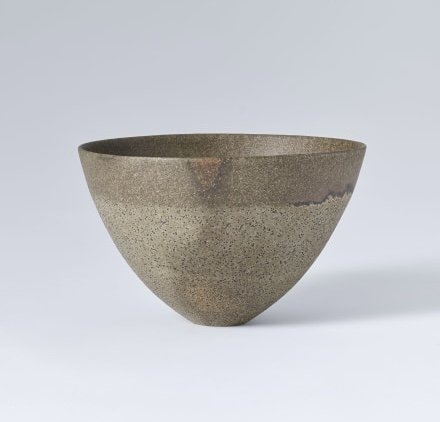John Swarbrooke Fine Art is delighted to exhibit for the first time at the British Art Fair 2024 on Stand 34.
Our inaugural, curated exhibition will feature painting, drawing and ceramics by pioneering 20th-century artists in conversation with a selection of contemporary artworks.
To enquire about an artwork please email art@johnswarbrooke.com
Edward BURRA CBE (1905-1976)
Still Life with Pot, c. 1955-57
stamped with signature
pencil, watercolour and gouache on paper
72.5 x 103.5 cm. (28 1⁄2 x 40 3⁄4 in.)
Sold
Provenance:
Lefevre Gallery, London.
Private Collection, UK.
Anon. sale; Sotheby’s, London, 10 December 2008, lot 54.
Private Collection, London, acquired at the above sale.
Edward Burra, perhaps more so than any other artist, is a master of the strange and the sinister. Whilst often overt in his depictions of the Spanish Civil War, or the seedy nightlife scenes of 1930s Harlem, it is even more quietly unsettling in those works in which he shows us the uncanny in the everyday - often where we least expect to encounter it. This is especially evident in the still life paintings that came to dominate the artist’s output from the 1950s onwards. Surreal and beguiling they challenge our traditional understanding of the genre, as celebrated in works such as Still Life with Pot and Still Life with Teeth, 1946 (Private Collection, currently on show at The Shape of Things: Still Life in Britain, Pallant House Gallery, Chichester).
In Still Life with Pot Burra depicts what is at first glance a typical and traditional ideal of the still life scene – favoured by artists from the Dutch Masters to Cézanne. But this is no ordinary still life – the plump and pointed fruit in the lower left becomes anthropomorphised, suggestive of the male genitalia, while the central vessel and folded fabrics suggest that of the female. They are being watched over by the glass decanters to the right. There is also a looming sense of decay that dominates the scene – with the central blue and white porcelain jar cracked, and the excellently rendered glassware appearing dusty and forgotten. As the artist recalled towards the end of his life
‘Everything looks menacing; I’m always expecting something calamitous to happen.’
- Edward Burra (J. Rothenstein, Tate, London, 1973)
This trompe l'oeil-esq still life displays the artist’s great ability within the medium of watercolour – effortlessly capturing surface textures and balancing the composition, rich with its bright, vivid colours. Yet it is his ability to make the still life subject so wonderfully surreal that really sets this work apart, providing nuanced readings that are a hallmark of the very best of the artist’s works.
Dame Lucie RIE DBE (1902-1995)
Bowl with Off-White and Pitted Glaze with Bronzed Rim, c. 1982
impressed with maker’s mark
stoneware with an off-white matt glaze and bronzed rim
height: 11 cm. (4 3/8 in.)
diameter: 19 cm. (7 1/2 in.)
POA
Born in Vienna in 1902, Lucie Rie arrived in Britain in 1938, fleeing Nazi-occupied Austria. Alongside a suitcase of carefully packed pots, she brought with her a profound appreciation of the very highest ideals of European Modernism. Rie irrevocably changed the course of the British art scene, reshaping perceptions of ceramics within the realms of art. Through her elegantly thrown stoneware and porcelain vessels, each decorated by hand with luscious, lustrous glazes, Rie not only paved the way for a future generation of makers but also catapulted ceramic arts in Britain onto a global stage.
John MINTON (1917-1957)
Illustration for ‘Time Was Away’ by Alan Ross
ink and watercolour on paper
36.5 x 26.5 cm. (14 3/4 x 10 3/8 in.)
SOLD
This drawing is a preparatory study for Alan Ross’s Corsican travelogue, Time Was Away, 1948, although it was not included in the final illustrations. The book was a collaboration between poet Alan Ross and John Minton. It portrays an artist at work in the Corsican mountains, capturing the élan of the draughtsman on a warm summer’s day.
Hans COPER (1920-1981)
Ovoid Pot with Disc, c. 1972
impressed with maker’s mark
stoneware, black glaze over a textured and incised body
height: 17 cm. (6 3⁄4 in.)
diameter: 13 cm. (5 1⁄8 in.)
POA
Provenance:
Kunstkammer Kösters, Moenchengladbach.
Private Collection, Germany.
Hagesheimer & Günther, Duesseldorf.
Private Collection, Germany.
Literature:
T. Birks, Hans Coper, London 1983, S. 134f.
In the catalogue for the 2022 Barbican exhibition Postwar Modern: New Art in Britain curator Hilary Floe discusses Hans Coper’s ‘mature language of boldly simplified forms with sensuously weathered, earth-toned surfaces’ that already by the 1950s he had become widely celebrated for. Originally apprenticed as a studio assistant to the Austrian-born ceramicist Lucie Rie at her home in Albion Mews, by the mid-1950s a firm friendship had struck up between the émigré pair, and they were sharing the studio space. Rie typically focusing on smaller, elegantly thrown bottles, vases, and domestic wares, whilst Coper became more adventurous and avant-garde, owing much to his earlier interest in sculpture and the work of Giacometti and Brancusi.
Sir Matthew Arnold Bracy SMITH CBE (1879-1959)
Still Life at Fryern, c. 1944
oil on canvas
61 x 51 cm. (24 x 20 in.)
£26,500 + ARR
Provenance:
David Gibbs, Director of Arthur Tooth & Sons, London (1950s- early 1960s) and Pace Gallery, New York (late 1960s).
Private Collection, New York, by descent from the above; and thence by descent to
Private Collection, Connecticut, acquired in 2005.
Exhibited:
London, Arts Council of Great Britain, Matthew Smith, 1947, no. 45. Southport, Atkinson Gallery, Modern Art Exhibition, summer 1950, n.n.
The title refers to Fryern Court, the home of Smith’s old friend Augustus John in Fordinbridge, Hampshire. This still life was most likely painted during the artist’s stay with John from August to October 1944.
Another version of the subject, Still Life at Fryern No. 2, was formerly in the collection of Lord & Lady Attenborough.
Denton WELCH (1915-1948)
Horse and Moon, c. 1943
initialled lower right D.W.
mixed media on paper
18 x 14 cm. (7 1⁄8 x 5 1⁄2 in.)
£12,500 + ARR
Denton Welch was a writer and artist who, despite his untimely death at the age of 33, received acclaim in his lifetime for the novels Maiden Voyage (1943) and In Youth is Pleasure (1944). Born in Shanghai, Denton studied painting at the Goldsmith School of Art. In 1935, he was severely injured in a cycling accident that left him an invalid for the rest of his life, and which would ultimately lead to his premature death. His artwork, a unique combination of the Gothic and Neo-Romantic, was exhibited frequently at the Leicester galleries in London.
The motif of the moon in the present work relates to the cover illustration for Maiden Voyage.
Celia Paul (b. 1959)
Jane, 2010
titled, signed and dated lower right Jane Celia Paul 2010
watercolour on paper
101.6 x 66 cm. (40 x 26 in.)
POA
Celia Paul’s art stems from a deep connection to the subject matter. Here, she makes an intimate depiction of her sister Jane, who appears to float ethereally on the sheet.
Dame Magdalene ODUNDO DBE (b. 1950)
Untitled, 1983-84
signed on the underside ODUNDO
burnished terracotta
height: 23.5 cm. (9 1/4 in.)
diameter: 21 cm. (8 1/4 in.)
POA
Dame Magdalene Odundo is rightly celebrated as one of the most important artists working today. For over forty years Odundo has continued to explore the sculptural versatility of clay through her unique and alluring ceramic forms. Graduating from the Royal College of Art in 1982, the Kenyan-born artist was met with a wave of support for her hand built (as opposed to wheel-thrown) vessels. Whilst studying at Farnham she visited the potter Michael Cardew (the first apprentice to Bernard Leach), who helped to facilitate a two-month residency at the Abuja pottery in Nigeria. There she watched the female makers – including most famously Ladi Kwali – coil build large water-jar forms that celebrated their local heritage. It was a turning point for Odundo, and one can see the origins of the water jar form in much of her work, with a rounded body or belly that meets the ground (as opposed to any sort of raised foot or base). As Odundo has said:
‘What is so beautiful about the pot is that it conveys a universal language, that of spiritual utility and aesthetic. It is revered and understood by all and therefore important to all … What else can tell you about human life more than a pot does?’
Jennifer LEE (b. 1956)
Fractionated olive, haloed trace, olive rim pot, 2006
painted with maker’s mark
stoneware with oxides
height: 10 cm. (4 in.)
diameter: 16 cm. (6 1/4 in.)
£35,000 + ARR
‘Jennifer Lee’s hand-built pots are instantly recognisable, and have become one of the hallmarks of British studio ceramics since their emergence in the early 1980s. These apparently simple container forms, stratified by metallic oxides, as if we are looking at sections and layers of earth or rock, meditate on the fundamentals of the vessel form, and in an elemental language that recalls some of the earliest pots, from the Mediterranean to Northern Europe. Lee’s pots tap such traditions to explore space, volume and contour, movement and stillness, the landscape of the ground under our feet, the textures and colours of our natural and human-made environments. Lee was born in Aberdeenshire, Scotland in 1956 and studied at the Edinburgh College of Art and London’s Royal College of Art from 1980-83. She lives and work in south London’ (text by David Whiting).
Prunella CLOUGH (1919-1999)
Dark Flower, 1997
oil on canvas
30.5 x 35 cm. (12 x 13 3⁄4 in.)
£9,500 + ARR
Prunella Clough (1919-1999) was one of the most original artists to emerge in the second half of the twentieth century. Born on November 11 in Knightsbridge. In 1937 Clough enrolled at Chelsea School of Art, where she took classes with the sculptor Henry Moore in the following year. Her studies were interrupted by the Second World War, in which she worked as an engineer's draughtsman and cartographer from 1940. After returning to painting after '45, Clough chose the pertinent subjects of post-war labour and the urban landscape. Alongside abstraction taking hold in British art in the 1950s, Clough began to focus further on the formal qualities of her subjects with her images becoming far less restrained. A solo exhibition at the Whitechapel in 1960 traced this journey and she enjoyed further retrospectives at the Serpentine in 1976 and Camden Art Centre in 1996. Shortly before her death in 1999 she was awarded the Jerwood Painting Prize and, with characteristic generosity, donated her prize towards supporting younger artists.
John MINTON (1917-1957)
Figures in a landscape
signed lower left John Minton
pen and ink on paper
24 x 31 cm. (9 1⁄2 x 12 1⁄4 in.)
£4,500 + ARR
‘Minton’s landscapes looked back to Samuel Palmer for their mood. They were densely patterned and luxuriantly coloured, and it was always the fullness and richness of the scene which attracted his eye and which he painted with such evident enjoyment’ (The Times, 1944).
Denton WELCH (1915-1948)
Reclining Male, 30 July 1943
dated and inscribed upper left July 30 1943 Noel Adeney
pencil on laid paper with a sketch on the verso
18 x 25 cm. (7 1⁄8 x 9 7⁄8 in.)
£3,750 + ARR
Dame Lucie RIE DBE (1902-1995)
Oval Bowl with Pink Spiral and Pitted Glaze, c. 1980
impressed with maker’s mark
stoneware with pink and cream pitted glaze
height: 13.5 cm. (5 1/4 in.)
diameter: 26.5 cm. (10 3/8 in.)
POA
Dame Lucie RIE DBE (1902-1995)
Bronzed Oval Bowl, c. 1983
impressed with maker's mark
porcelain with a bronze glaze, and terracotta well with turquoise band
height: 8.5 cm. (3 3⁄8 in.)
diameter: 16 cm. (6 1⁄4 in.)
POA
John MINTON (1917-1957)
Lambeth Street I and Lambeth Street II
both signed upper right John Minton
pen and ink wash on paper
18.1 x 23.2 cm. (9 1⁄8 x 7 1⁄8 in.)
16.8 x 21.9 cm. (6 6⁄8 x 8 5⁄8 in.)
The Pair: SOLD
In the late 1930s, John Minton and a number of artists began to associate themselves with English Neo-Romanticism. Influenced by the visionary landscapes of William Blake and Samuel Palmer, as well as the French Neo-Romantics, Eugene Berman and Pavel Tchelitchew, they sought to rediscover romantic sources of inspiration and technique rather than following the popular trends of Modern Art. Under this influence, Minton and his peers came to focus on images of subjectivity and poetic intensity, often inspired by nature. Minton’s melancholic compositions from this period are often arranged in a stage-set design within which perspective, especially of the human figure, is subtly distorted. A recurring theme in Minton’s work was that of a lone, often male figure, placed in an emotionally charged setting.
Lambeth Street 1 & 2 capture the tortured landscape of wartime London, presenting scenes poised between emotional intensity and physical barrenness and yet also. The solitary figure of a boy and girl respectively capture the melancholic resignation amidst a desolate wasteland. This forlorn, war-torn boy, directly in the foreground, stands within, and yet somehow apart from, this backdrop of destruction and ruin: the derelict buildings, the abandoned figures and a haunting sky captured powerfully in pen and ink wash.
Lucy HARWOOD (1893-1972)
Bad Homburg, Germany
signed and inscribed on the verso LUCY HARWOOD BAD HOMBURG
oil on canvas
61 x 51 cm. (24 x 20 3⁄8 in.)
£4,500 + ARR
Bad Homburg was painted during one of Lucy Harwood’s frequent trips to the continent, the intricately impastoed surface and bold palette revealing the influence of her mentor, Cedric Morris.
Lucy Harwood was born in 1893 at Belstead Park near Ipswich. As a teenage girl Lucy had shown outstanding musical ability and planned to become a professional pianist but a failed operation paralysed her right side, obliging her to abandon her musical ambitions. After studying Fine Art she attended classes at the Slade, showed a talent for drawing and after the death of her mother in 1938, moved to Octagon House, Dedham, becoming, at the age of 45, one of the first students at the East Anglian School of Drawing and Painting set up by Cedric Morris and Arthur Lett-Haines. In later life Harwood’s spontaneous style and sense of colour won her approval from Cedric Morris, Augustus John and Matthew Smith.
When in 1940 the School accidentally burned down and moved to The Pound in Higham and later to Benton End Lucy bought a house in the nearby village of Upper Layham where she lived until her death. As Maggi Hambling, a former student, has said: ‘people maintained a respectful distance both from her paint-spattered car and the lethal port wine she served to visitors.’
William BROOKER (1918-1983)
Untitled, 1962
graphite and charcoal on paper
52 x 52 cm. (20 1⁄2 x 20 1⁄2 in.)
SOLD
A pioneer of the still life in modern British art, William Brooker was born in Surrey in 1918, initially studying at the Croydon School of Art in 1936, following which he served within the Royal Artillery during the Second World War. He later finished his studies at both the Chelsea School of Art and Goldsmiths College of Art from 1947 to 1949. Brooker taught at Bath Academy of Art (1949 – 53). In 1968 he travelled to America and Zambia, exhibiting alongside William Scott in a show organised by the British Council. Howard Hodgkin, a pupil, called him “a great teacher”.
Untitled, 1962 reflects William Brooker’s movement towards abstraction in the last decades of his career; this move was hinted at in his earlier works, which often reduce the items of the studio, the tables pots and brushes, into a geometric scheme. Here he refines the still life to its essential formal elements, the graphite shading capturing the light and shapes of the studio with great dexterity.


























